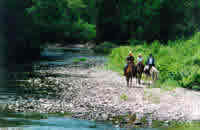
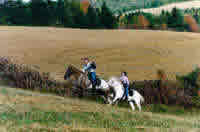
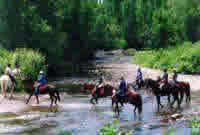
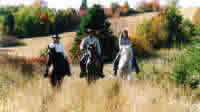
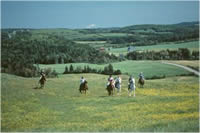
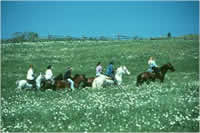
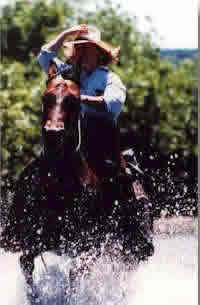
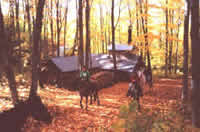
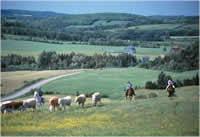
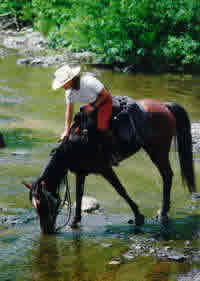
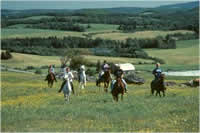
|
Even
the horse spoke French, or at least understood French commands,
on our six-day around the Gaspe Peninsula last fall.
This was the second weeklong horseback trip my husband and
I have taken. Two years earlier, we headed into the Rock Mountains
of Colorado for six days, camping out each night. Sinking
into a warm bed after a hot shower every night seemed an appealing
alternative, so this time we chose an inn-to-inn ride.
The rural peninsula area was just as wild and beautiful as
the Rockies, if not as high. And it was fun being immersed
in the French Canadian culture, even if our horses often exhibited
a better command of the language than we did (Not everyone
in French Québec can, or will, speak English.)
Though we ride fairly regularly, it was the most intense horseback
trip we’ve ever experienced. With more than 100 miles
to cover in five days, we spent more hours in the saddle every
day, with frequently changing tempos and terrain, than riders
usually experience even on long rides.
Along with the riding, we enjoyed charming country inns, beautiful
scenery, sore muscles, good food and friendly people.
We assembled on the last Sunday in August and finished on
the first Saturday in September. Here’s how our adventure
went:
The
riders assemble
On a cool evening a group of riders gathers at the Une Ferme
en Gaspesie (A Farm in Gaspesie,) an inn just outside the
tiny town of Mont Joli. We had driven up the western coast
of the peninsula from Quebec City, a gorgeous five-hour
trip, arriving in time for dinner.
The eight riders assembled for the trip range from a 23
year-old who has been riding half her life to a 60 –year-old
grandmother who took up riding just four years ago. Other
than all being from the United States, we seem to have little
in common except for one, unifying thing -a passion for
horses.
Our innkeeper, Pierre Dufort, is a jolly, fervent French
Canadian who is proud of his austere, spotless inn and the
fine food he serves. For dinner we have a choice of six
entrees: lamb, pheasant, rabbit, pork, beef or shrimp. Only
the shrimp isn’t from Pierre’s farm. It came from
Matane, a fishing village 12 miles away. The vegetables
were picked fresh from the garden outside the kitchen door.
The desserts are rich.
Shortly before dinner is served, we meet our guides, the
Pruneaus, who will lead us for the next five days. The couple
owns Ranch Des Collines Chic Chocs in St. Damase, Quebec.
Yves has been running horse trips in the area for seven
years. His wife, Heather, joined him four years ago.
The first night, the Pruneaus size us up, matching our abilities
with specific mounts. The horses are as diverse as our group,
ranging from a dainty Arabian mare almost small enough to
qualify as a pony to a large draft horse Yves sometimes
uses to log with in the winter.
Day One: At a gallop
Saddling up for the first day, we’re on the trail by
9:30 after a breakfast of crepes, waffles, bacon and sausage.
We are scheduled to roam through the Tartigou River Valley
and along the Evergreen Trail, a tunnel of conifers so dense
it nearly blocks out the sun. At one point, Yves orders
the horses into a canter and they fly along almost silently
on the soft floor of pine needles. For a moment, when the
trail turns, I lose sight of my co-riders and it seems I’m
galloping alone, brushing past the trees, my hat blown back,
my hair flying from the strong strides of Ti Loup, my Canadian-bred
horse.
Too soon, we round a curve and I see the now-familiar sign
coming down the line of riders; a fist, raised in the air
and pumping up and down. Ti Loup (French for “Little
Wolf” - an irony because he is a huge draft horse)
sees the signal about the same time I do and eases back
into a bone-jarring trot.
Yves keeps the tempo changing, rarely staying at a walk
for more than 15 minutes. Riders are expected to post during
trots. As we ride in, we pass large pastures full of skittish
red deer, who shy from our horses. We ride up to the back
door of the farmhouse, shuck off our boots and enter the
homey kitchen.
Although the woman inside speaks only French, we show our
appreciation for her simple but hearty meal. In the afternoon,
we ride through a massive maple forest. As the sun begins
to set, we ride along the edges of fields with freshly bailed
hay waiting to be stored for the approaching harsh winter.
In the distance, we see the sparkling St. Lawrence Seaway,
a constant companion on this trip. We arrive at our evening
destination, Lac Malcom, the only hotel we visit during
the trip and the only accommodations with private bathrooms.
Some of the riders swim or boat in the lake, others nap
before dinner.
Day
Two: Blueberries, hills
After treating the hotel owner’s children to a quick
ride, we head out along back-country roads where local drivers
are considerate of the horses, slowing or even stopping
to allow riders to pass. Crossing into a balsam forest,
we take trails and dirt roads to the home of a blueberry
farmer, where the owner has lunch waiting. Dessert is a
yummy blueberry cake.
The afternoon takes us into the Chic Choc Hills, including
some rather steep climbs. But Yves decides against climbing
the highest of the hills, which is 1,350 ft above sea level,
so we miss out on the promised panoramic view that would
allow us to see all the way to the Atlantic Ocean. The weather
is just too hot for the horses. Of course, temperature is
relative. For Canadians, where winters are severe and below-Zero
temperatures common, 75 degrees is warm. That’s where
the thermometer hovers this week, very high for early September,
and our guides apologize. But we find it perfect riding
with the August heat wave we left behind in Atlanta.
As the afternoon winds down, Yves and Heather take us to
a hidden pool, complete with waterfall. Only Yves and two
of the riders are brave enough to dive in, but the rest
of us enjoy dipping our feet in the chilly water.
During one of the climbs, we’re afforded a brilliant
view of the St. Lawrence, where boats and ships slip up
from the Quebec area, heading for the open sea. Our stop
for the evening is Le Jardin de Giver (The Garden of Frost),
owned by Dinette and Gerald Couture. Yves helped build the
inn, which is beautifully decorated with polished wood furniture,
local artwork and dozens of pictures. Ginette prepares lush
breakfasts that include French toast, four homemade jams
and soft-boiled eggs. Dinners are three-course gourmet affairs
that include cream of tomato soup, stuffed squash, lentil
pilaf and braised beef. Vegetables are picked an hour or
two before each meal, and each plate is decorated with edible
flowers from the garden. After dinner, Ginette entertains
guests with her lovely singing and piano playing. Later,
we step outside and discover the Milky Way looking like
a streak of cotton streaming across the sky with tiny Christmas
lights twinkling within.
Day
Three: Logging miles
We will be staying at Le Jardin de Givre again tonight,
so Yves pulls out detailed maps to show us today’s
route. We returnto the Chic Choc Hills, often taking logging
roads. On many of the dirt roads, felled trees are stacked,
sometimes more than 10 feet high, waiting to be dragged
away.
We pass a logger hauling downed trees to the roadside, and
Yves stops to chat. He has permission to cross many owners’
land because his tours bring much-need money into the area.
Yves identifies plants and trees for the riders. But with
10 horse clumping along, we see little wildlife, except
for a covey of grouse we scare up this morning on another
dirt logging road. Lunch is at a trout farm where several
riders volunteer to catch tonight’s dinner. In the
ponds - just small holes where we can see hundreds of fish
swimming near the bottom - it takes less than 10 minutes
to catch eight trout (two of the riders are vegetarians).
Heather and Yves clean the fish, and then a local woman,
who also drops off lunch, drives the catch back to Le Jardin
de Givre where Ginette will prepare it.
In the afternoon, the ride heads through fields and past
farms as we work our way toward a group of giant windmills
that produce electricity for nearly 300 homes. The windmills,
up to 240 feet high, overlook the St. Lawrence and the Atlantic.
As we race up the hill where the windmills stand majestically,
one rider is thrown, although not seriously injured, when
his horse spooks at a piece of white plastic sheeting that
six other horses ran right past.
“Our first fall of the season,” Yves says with
a sigh. The man’s wrist is slightly sprained, but he
continues the ride.
Riders can war helmets if they choose, but it’s not
required. Heather says safety hasn’t been a big problem,
but people have quit mid-ride because of the ride’s
rigors.
“We try to let people know this is a strenuous ride
so we can avoid that.” Heather says, “Because
no one’s happy when that happens.”
Later, back at Le Jardin de Givre, Ginette brings out the
perfectly cooked whole fish, and Yves gives us a quick lesson
in how to easily debone a trout.
Day
Four: Country Roads
Today’s ride covers all types of terrain, from forests
to farms to country roads. We cross the South White river,
allowing the horses to drink from the cool, fast-running
water. Lunch is pulled from our saddlebags and enjoyed by
a lovely lake. We ride country roads in the afternoon. The
rides are a bit longer each day, and even Heather admits
to being sore by Thursday. This is the only day we don’t
ride to our inn. We leave the horses at a barn outside of
Padoug and are driven into town, where we stay at La Villa
Clocher, an old church rectory that has been restored into
a stunning bed and-breakfast.
Dinner is a traditional fondue, and Yves jokes that anyone
who drops anything into the hot oil must help clean the
horses in the morning. Actually, riders can do as much or
as little as they want on the ride. If you want to feed,
brush and saddle your horse daily, you may, or you can let
the Pruneaus do it all.
Day
Five: Tired, satisfied
We ride though the rolling meadows and scrubby pine forests
on our way to an organic farm in Baie Des Sables (Sandy
Bay), where owner Lise Beaulieu has lunch waiting. After
serving us quiche, salsa, homemade bread and pie, Lise takes
us on a tour of her farm.
The
afternoon ride goes into the small town of Les Boles before
turning to the St. Lawrence shoreline, where we walk the
horses for four miles, while searching the water for seals,
eider ducks and cormorants bouncing with the ocean waves.
The walk along the shore culminates in the 1 ¼ mile
“Bonsai Canter.” Yves says the ride is names for
a pine that once stood at the end of the run that looked
like a bonsai tree. When Yves gives the signal, the pack
begins running. Hats blow back hair flies up and the horses
seem to enjoy the run as much as the riders.
Then we ride several more hours, winding our way back to
Une Ferme en Gaspesie and our original innkeeper, Pierre.
We are a tired group, but we are also happy. We have made
new friends and have become better equestrians.
After dinner, Pierre pours a special local drink and offers
a toast to the ride, our guides and our success.
We raise our glasses to toast Yves and Heather and knock
back a shooter of rum and maple syrup, shouting
“Tzigidou.”
Loose translation?
“Everything is all right.”
For
more information please visit www.hiddentrails.com
|







